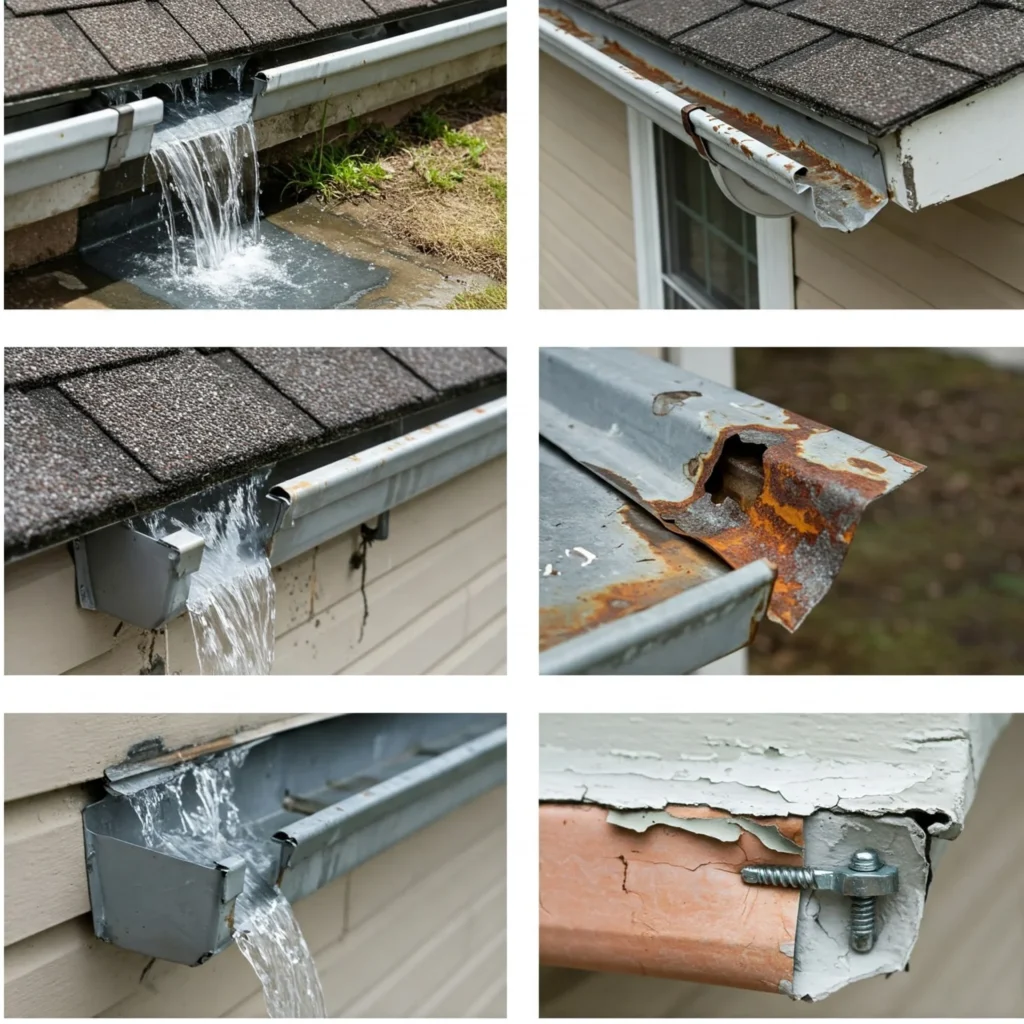If you’re thinking about installing new gutters, you’re probably wondering: How much will it cost? The answer depends on several factors, from the type of material to the size of your home. In this guide, we’ll break down everything you need to know about gutter installation costs so you can budget confidently.
Table of Contents
ToggleThe Importance of Gutters for Your Home
Gutters play a crucial role in protecting your home from water damage. Without them, rainwater can accumulate around your foundation, leading to costly repairs. Here’s why gutters are essential:
Prevent Water Damage – Gutters channel rainwater away from your home’s foundation, siding, and landscaping, reducing erosion and structural damage.
Avoid Basement Flooding – Properly installed gutters help prevent water from seeping into your basement, reducing the risk of mold and mildew.
Protect Your Roof – Gutters prevent water buildup on your roof, which can lead to leaks, rot, and costly repairs.
Enhance Curb Appeal – Well-maintained gutters improve the overall look of your home and increase its value.
Reduce Soil Erosion – Without gutters, water runoff can wash away soil around your home, potentially damaging your landscaping.
Signs That You Need New Gutters
Over time, gutters wear out and may need to be replaced. Here are some common signs that indicate it’s time for new gutters:
Cracks or Splits – Even small cracks can grow over time, leading to leaks and water damage.
Peeling Paint or Rust – This suggests that water is not being properly diverted, leading to deterioration.
Sagging or Pulling Away from the House – Gutters should remain firmly attached. If they’re sagging, they might be clogged or too damaged to function properly.
Frequent Clogs and Overflowing Water – If you constantly deal with clogged gutters, it might be time for a replacement or an upgrade with gutter guards.
Water Damage Around the Foundation – Pooled water or erosion near your foundation suggests your gutters aren’t working as they should.
Mold or Mildew Growth – Excess moisture from faulty gutters can cause mold to develop on your home’s exterior walls or basement.
If you notice any of these issues, it may be time to invest in new gutters to protect your home from further damage.
Different Types of Gutters and Their Pros and Cons
Choosing the right type of gutter is important for durability, aesthetics, and budget. Here are the most common gutter types and their advantages and disadvantages:
1. Vinyl Gutters
Pros:
Affordable and lightweight
Easy to install (good for DIY projects)
Won’t rust or corrode
Cons:
Can become brittle and crack in extreme temperatures
Not as durable as metal options
May fade over time due to sun exposure
2. Aluminum Gutters
Pros:
Lightweight yet durable
Rust-resistant and low maintenance
Available in a variety of colors
Cons:
Can dent easily from debris or ladders
Not as strong as steel or copper
3. Steel Gutters
Pros:
Extremely strong and long-lasting
Ideal for areas with heavy rain or snow
Available in galvanized or stainless steel
Cons:
More expensive than vinyl or aluminum
Prone to rust if not properly maintained
Heavy and may require professional installation
4. Copper Gutters
Pros:
Elegant and aesthetically appealing
Extremely durable and long-lasting (can last over 50 years)
Naturally resistant to rust and corrosion
Cons:
Very expensive
Develops a patina over time (which some may not prefer)
Requires professional installation
5. Seamless Gutters
Pros:
Custom-made for a perfect fit
Fewer seams mean reduced chances of leaks
Available in multiple materials (aluminum, steel, copper)
Cons:
More expensive than sectional gutters
Must be professionally installed
Difficult to replace or repair a single section
Understanding the Pricing Structure for Gutter Installation
Gutter installation pricing can be broken down into several key components. Understanding these factors can help you budget more effectively and avoid unexpected costs:
Material Costs – The type of gutter material you choose greatly affects the overall price. Vinyl is the cheapest, while copper is the most expensive.
Labor Costs – Professional installation costs vary depending on the complexity of the job, the contractor’s experience, and your location.
Gutter Length – The total linear feet of gutter needed for your home determines the base cost. Larger homes require more material and labor.
Installation Complexity – Homes with multiple stories, steep roofs, or intricate architectural features may require additional work, increasing labor costs.
Additional Features – Upgrades like seamless gutters, custom colors, or protective coatings will add to the final price but may enhance durability and appearance.
How Much Does Gutter Installation Cost?
On average, homeowners spend $1,000 to $2,500 for new gutters, but the price can vary based on materials, labor, and home size. Here’s a general cost breakdown:
Vinyl Gutters – These cost $3 to $6 per linear foot, making them one of the most affordable options. While easy to install, they may not hold up well in extreme temperatures and can become brittle over time, leading to cracks and leaks.
Aluminum Gutters – Expect to pay $6 to $12 per linear foot for this lightweight and durable option. Aluminum gutters resist rust and are available in many colors, but they can dent easily, which may require repairs over time.
Steel Gutters – Priced at $9 to $20 per linear foot, steel gutters offer excellent durability and strength. They are ideal for areas with heavy rainfall or snow but require proper maintenance to prevent rust and corrosion.
Copper Gutters – These premium gutters cost $25 to $40 per linear foot due to their long lifespan and elegant appearance. Copper naturally resists corrosion, but the high upfront cost and professional installation requirements may be a downside for some homeowners.
Seamless Gutters – A seamless system typically costs $10 to $30 per linear foot, depending on the material. With fewer leaks and a custom fit, they are a superior choice, but professional installation is required, making them more expensive overall.
A standard home typically needs 100 to 200 feet of gutters, so your total cost will depend on how much material you need.
Additional Costs to Consider When Installing New Gutters
Beyond the basic materials and labor, there are other costs you should factor into your budget:
Gutter Guards – These cost $3 to $12 per linear foot and help prevent leaves and debris from clogging your gutters. They reduce maintenance needs and extend the lifespan of your gutters but add to the upfront expense.
Downspouts – Priced at $5 to $25 per piece, downspouts direct water away from your home’s foundation. The number and placement of downspouts can influence overall costs, ensuring proper drainage and preventing water damage.
Fascia and Soffit Repairs – These cost $6 to $20 per linear foot and may be necessary if your existing structures are damaged. Rotten or weakened fascia boards must be replaced to properly support the new gutters and ensure stability.
Gutter Removal and Disposal – Expect to pay $100 to $300 if your old gutters need removal. Some professionals charge extra for disposing of the old materials, so it’s important to check if this is included in your installation quote.
Heated Gutter Systems – At $20 to $30 per linear foot, these systems prevent ice buildup in colder climates. While they increase upfront costs, they help prevent ice dams, which can cause serious damage to your roof and gutters.
Custom Colors or Finishes – Adding special colors or finishes costs $2 to $5 per linear foot. This customization enhances curb appeal and allows you to match your gutters with your home’s exterior, though it adds to the total price.
DIY vs. Professional Gutter Installation: Which is Right for You?
Installing gutters yourself can save money, but it requires skill and effort. Here’s how DIY compares to hiring a professional:
DIY Installation
Pros:
Lower cost (no labor fees)
Flexibility to work at your own pace
Good option for smaller homes
Cons:
Requires proper tools and materials
Risk of improper installation, leading to leaks or damage
Can be time-consuming and physically demanding
Professional Installation
Pros:
Ensures proper installation with warranties
Faster completion with expert knowledge
Less risk of injury or mistakes
Cons:
Higher upfront cost due to labor fees
Need to research and hire a reputable contractor
If you’re handy and have experience with home improvement projects, DIY might be a good option. However, if you want a worry-free installation with guaranteed results, hiring a professional is the best choice.
Use Case: Real-Life Scenario
Issue:
John, a homeowner in Texas, noticed water pooling around his foundation after heavy rains. He also saw paint peeling from his exterior walls and mold growth in his basement. After researching, John realized his old gutters were no longer effective and were causing significant water damage to his home.
Solution:
John contacted R.L. NELSON Foundation Solutions for a professional gutter installation. By choosing seamless aluminum gutters, John reduced maintenance, improved his home’s curb appeal, and prevented costly foundation repairs in the future. This real-life scenario highlights how investing in proper gutters can save you money and protect your home from damage.
Conclusion: Making an Informed Decision About Pricing New Gutters
Investing in new gutters is an important decision that protects your home from costly water damage. By understanding the different types of gutters, their costs, and the factors that influence pricing, you can make the best choice for your home and budget. Whether you opt for a DIY approach or hire a professional, selecting the right gutters will enhance your home’s longevity, functionality, and curb appeal.
Need a quote? Reach out to R.L. NELSON Foundation Solutions at 281-420-1739 and get started on protecting your home!
Frequently Asked Questions (FAQs)
How long do gutters typically last?
The lifespan of gutters depends on the material. Vinyl gutters last about 10-20 years, aluminum gutters 20-30 years, steel gutters 20-40 years, and copper gutters can last 50 years or more with proper maintenance.
How often should I clean my gutters?
Most homeowners should clean their gutters at least twice a year, in the spring and fall. If you have a lot of trees near your home, you may need to clean them more frequently to prevent clogs.
Are seamless gutters worth the extra cost?
Yes, seamless gutters are a great investment because they reduce the chances of leaks and require less maintenance than sectional gutters. While they cost more upfront, they offer greater durability and a cleaner appearance.
Can I install gutters myself?
DIY installation is possible, especially for vinyl or aluminum gutters. However, professional installation ensures proper alignment, drainage, and durability especially for seamless or heavy-duty materials like steel and copper.






